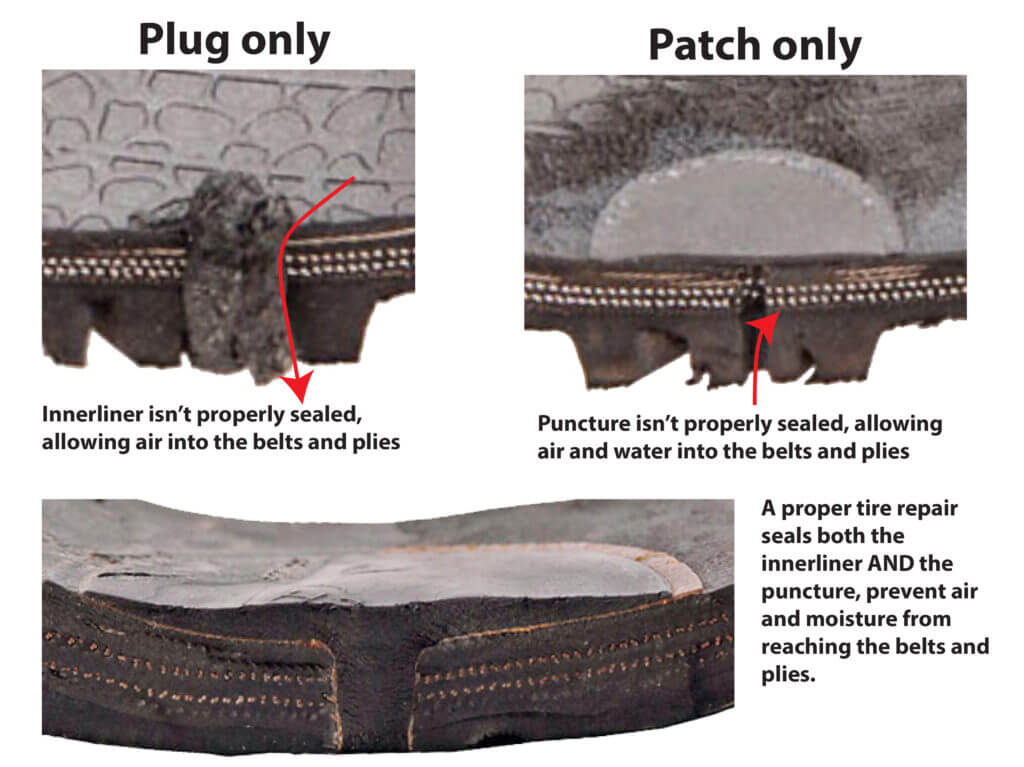So, you have a flat tire or one that’s leaking air. It’s not the end of the world. Luckily there are safe and cost-effective ways to properly repair most tire punctures. The purpose of this article is to show you the difference between a safe, permanent repair and a temporary string, plug or patch repair.
According to the National Highway Traffic Safety Administration (NHSTA) and the Tire Industry Association (TIA), the only method to properly repair a tire puncture is to fill the injury with a repair stem and back the stem with a repair patch. This is commonly known as a combination repair or a patch/plug repair.
Patch/plug repairs are most often performed using a one-piece repair unit that combines the repair stem and cap (or patch) into one unit. However, special circumstances may require the use of a two-piece combination repair (ex. If the angle of the puncture exceeds 35 degrees). The repair is then permanently bonded to the inside of tire and through the injury channel using a cold, chemical vulcanizing process.
The repair essentially becomes part of the tire, creating an air-tight seal that keeps air in and moisture and contaminants out (more on this procedure below).
Emergency roadside plug repairs are NOT intended to be a permanent tire repair. Plugs and string repairs are designed to get you back up and rolling long enough to get home or to the nearest service center to perform a proper tire repair.
The common misconception with plug and string repairs is that because they hold air, they are safe to use. While it is true that many plug repairs do a great job of keeping air in the tire, that’s only part of the equation. Because they’re not completely sealing the injury, plug repairs may allow air and moisture to penetrate the body of the tire. Over time, this could lead to a dangerous (or even deadly) blowout.
A Patch-Only Tire Repair Leaves Your Tire Susceptible to DamageA tire repair that uses only a patch is also NOT considered proper or safe. A properly installed patch will do a great job of allowing the tire to hold air. However, similarly to the plug-only repair, the patch does not fill the injury channel. Therefore, air and moisture could seep into the tire from the tread surface and eventually damage the tire.
A properly installed patch will do a great job of allowing the tire to hold air. However, similarly to the plug-only repair, the patch does not fill the injury channel. Therefore, air and moisture could seep into the tire from the tread surface and eventually damage the tire.
Only a proper patch/plug repair completely seals the puncture from inside the tire and through the entire injury channel. There are a few extra steps necessary to perform a proper tire repair in accordance with industry guidelines. We’ve developed a simple acronym to help organize and remember the steps: R.E.P.A.I.R.
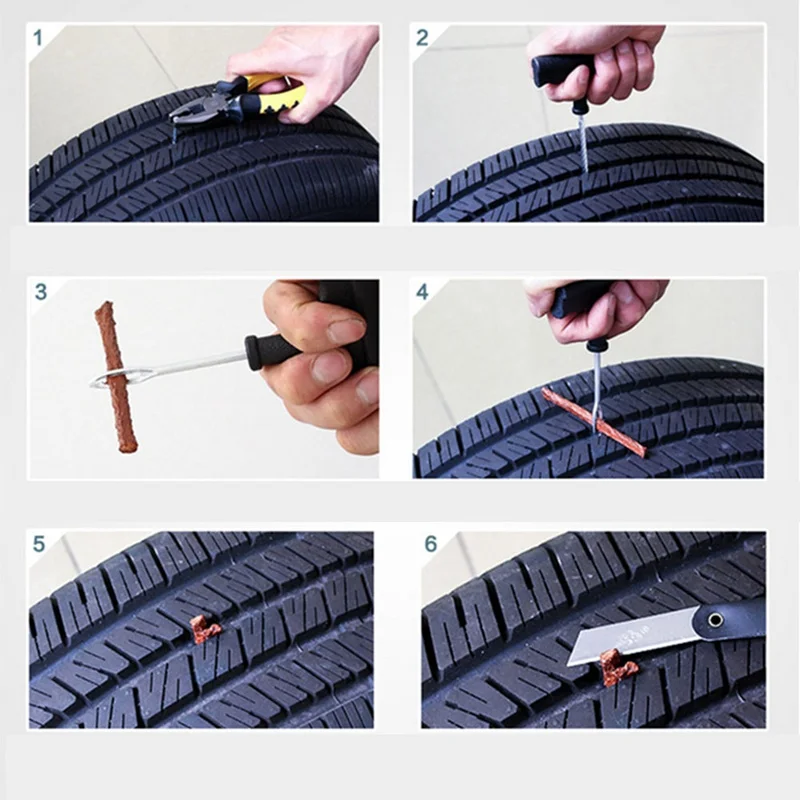 It can also be determined if the puncture did any significant damage to the cords or belts.
It can also be determined if the puncture did any significant damage to the cords or belts.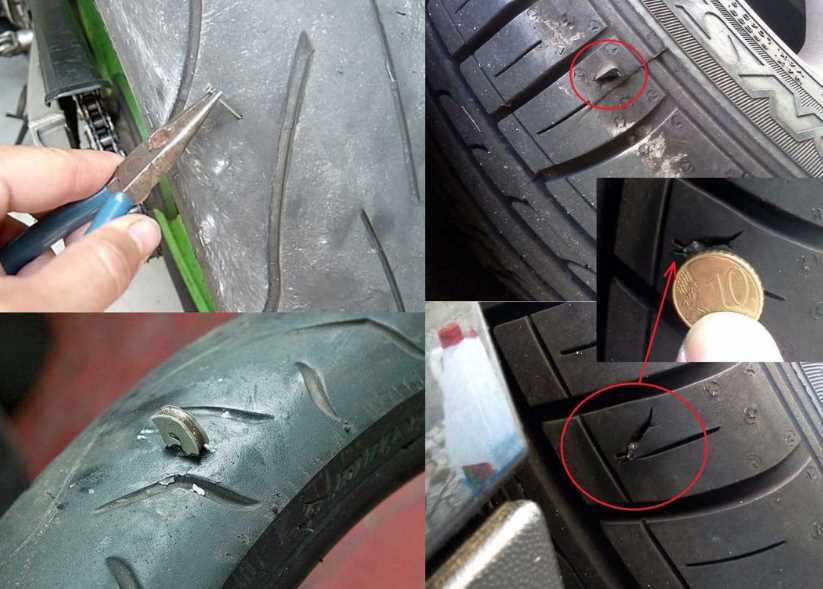 The over-buffed area of the inner liner is treated with a thin layer of rubber sealant, and the excess repair is trimmed to approximately ¼” above the tread surface.
The over-buffed area of the inner liner is treated with a thin layer of rubber sealant, and the excess repair is trimmed to approximately ¼” above the tread surface.There are a number of factors that may determine whether or not your tire is safe to repair. These factors fall into three main categories:
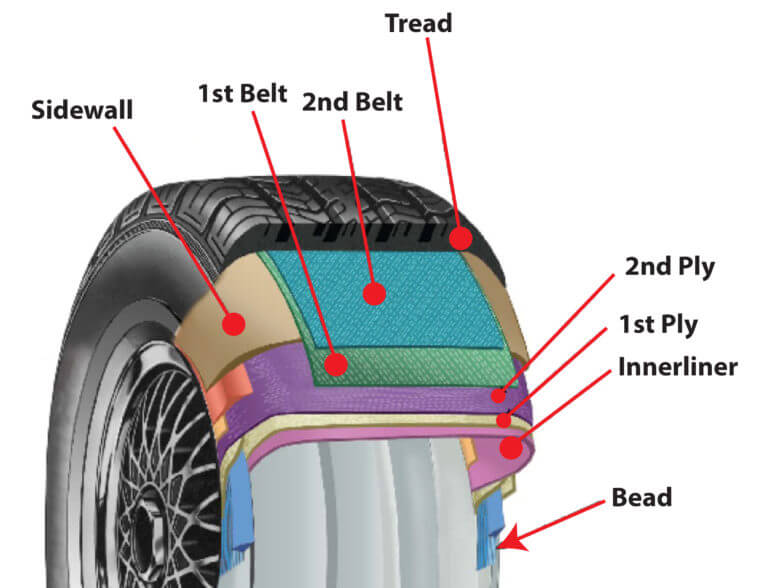 Excessive wear, casing separation, impact damage and other conditions may make it unsafe to properly repair your tire. For a more comprehensive list of repairable vs. non-repairable conditions visit our blog Can Your Tire Be Repaired?
Excessive wear, casing separation, impact damage and other conditions may make it unsafe to properly repair your tire. For a more comprehensive list of repairable vs. non-repairable conditions visit our blog Can Your Tire Be Repaired?The occasional flat or leaky tire is an unavoidable part of life. But, taking shortcuts to repair it can be dangerous to you and your passengers. Take the time and do the research to do the job right and/or find a reputable tire repair shop trained in proper tire repair procedure.
By Admin
Posted in Uncategorized
Flat tires can happen at any time and can make you feel helpless. But if you are armed with some information and quick fixes, you should be back on the road quickly.
If you notice that your tire is flat but still has some air in it, you might be able to fix it with a tire patch as long as the hole is not in the sidewall. You should never drive on a tire that is more than ten pounds low on air. If the leak allows the rest of the air out, you could end up driving on the rim, which will cause damage. So what should you do when it seems like your tire is low?
You should never drive on a tire that is more than ten pounds low on air. If the leak allows the rest of the air out, you could end up driving on the rim, which will cause damage. So what should you do when it seems like your tire is low?
Jack the vehicle up using the jack points closest to the tire. Slowly rotate the tire to find the problem. If you don’t see an object sticking out of the tire or a hole, there’s a trick to discovering the leak. Make a mixture of liquid soap and water. As you brush the water on the tire, the mixture will create bubbles where the hole is located. If you mark the hole with chalk or white shoe polish you can easily find it again.
If the hole was caused by a nail or screw and is small, you can plug the tire, but larger holes will need to be patched. A tire plug kit contains two T handles: One has a point and a rough shaft and the other has an “eye” at the end of it.
Air the tire up to about five pounds over the recommended pressure.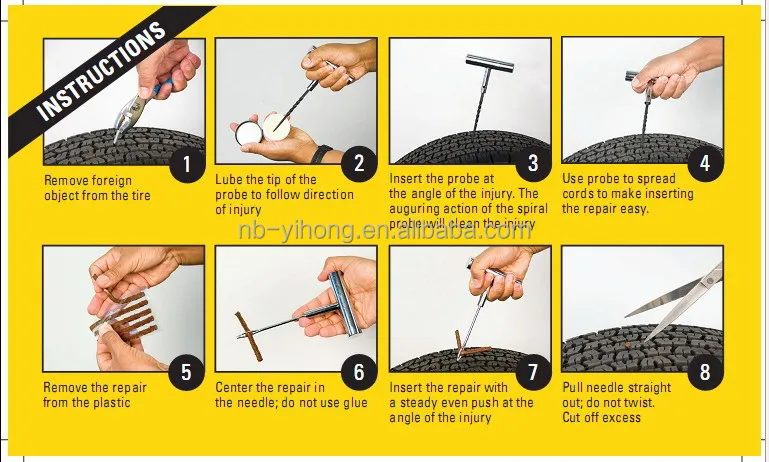 Next, thread a plug through the eye on the smooth-shafted T handle. Insert the T handle without the eye into the hole in the tire. Push it in and pull it out three or four times. Remove the T handle and then push the plug-loaded T handle into the hole in the tire so that the plug is all the way inside the tire. Pull the T handle out. The plug will stay in the tire and will be visible.
Next, thread a plug through the eye on the smooth-shafted T handle. Insert the T handle without the eye into the hole in the tire. Push it in and pull it out three or four times. Remove the T handle and then push the plug-loaded T handle into the hole in the tire so that the plug is all the way inside the tire. Pull the T handle out. The plug will stay in the tire and will be visible.
While you can patch a tire yourself, it may be better to bring your car to a tire shop. You must first remove the tire to install the tire patch and then remove the tire from the rim. While it’s possible to do this yourself, it can get pretty complicated.
If the hole is too big to plug, you shouldn’t try to drive. A hole that’s big enough for a patch will leak quickly. The easiest and best thing to do to avoid damaging your rim is bring the tire to a tire repair center.
If you must drive the vehicle, remove the damaged tire and wheel, and install the spare. If you have another mode of transportation, remove the tire and wheel, and bring it to a tire repair center so it can be repaired safely.
If you have another mode of transportation, remove the tire and wheel, and bring it to a tire repair center so it can be repaired safely.
You can drive for many miles on a plug or patch, however, if you notice another leak it may be time to head to a service center. If you need a second tire patch, the tire is ready to be replaced.
Safety is always the number one priority. A tire patch can help with a small leak, but if more than one is needed, it’s time for a replacement.
Unit/system: Wheels
Fault: How to fix a puncture on the road
 )
)
Never drive on a flat tire!
Possible consequences of failure to eliminate
Driving on a flat tire or with low pressure can lead to complete tire wear, deformation of the rim, as well as to an emergency!
First of all, you need to try to pump up the wheel and get to the tire shop. In case the wheel deflates very quickly, it is necessary to apply a special Liqui Moly sealant spray.
The use of the Reifen-Reparatur-Spray Tire Repair Spray allows you to quickly and independently repair and inflate tubeless tire punctures when operating the car in places remote from the service. Allows you to get to the tire shop without changing the wheel. The contents of the cylinder are sufficient for pumping into a tire up to size 215.
Code: 3343
Volume: 0.5 l
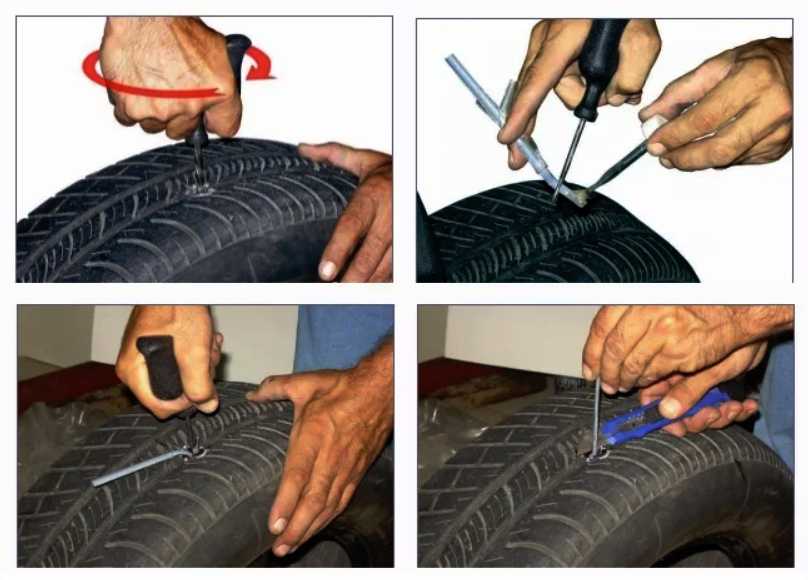
Do not use if the tire is torn or comes off the rim. It is not recommended for use in the presence of a centralized tire pressure monitoring system.
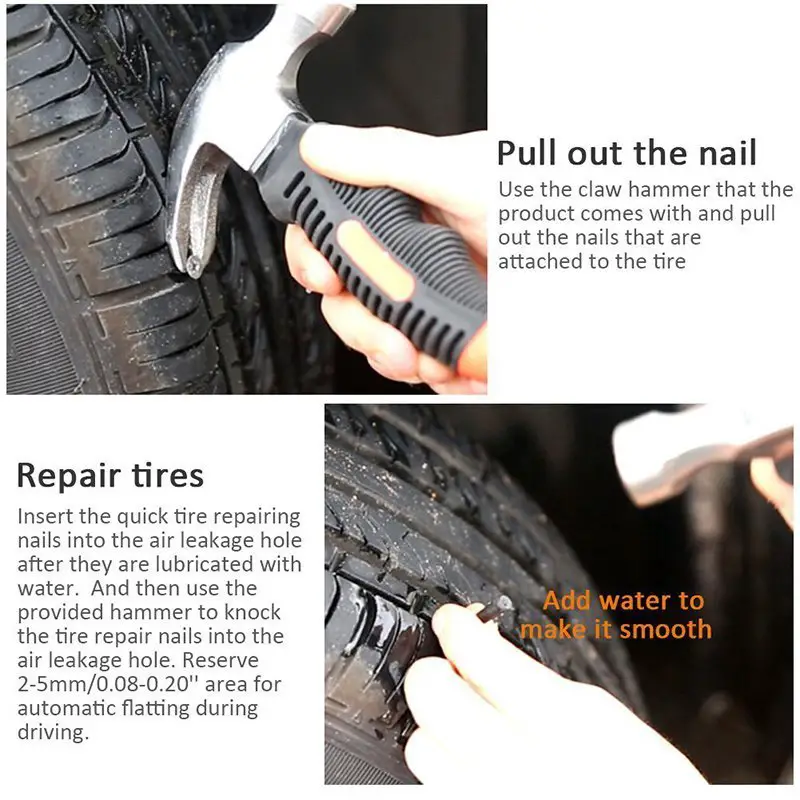
Reifen-Reparatur-Spray tire repair spray allows you to quickly and reliably repair damage, continue driving without changing the wheel.
Bicycle
Code: 6056
Volume: 75 ml
Motorcycle
Code: 1579
Volume: 300 ml
Vehicle
Code: 3343
Volume: 500 ml
Photo: Mikhail Tereshchenko / TASS
adv.rbc.ru
See also
Nail, rebar or sharp stone - sometimes you can damage a tire almost from scratch. First of all, the scale of damage is important, and often rubber can still be repaired. Most often, motorists turn to tire shops for repairs in the middle of autumn or spring - just in the season of replacing summer tires with winter tires and vice versa.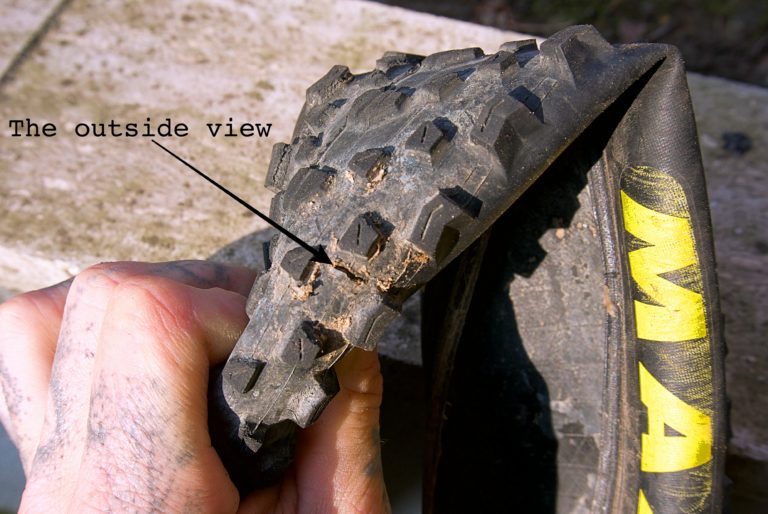 In order not to stand in lines, it is worth knowing exactly when to go to the tire shop and when to go to the store.
In order not to stand in lines, it is worth knowing exactly when to go to the tire shop and when to go to the store.
The most common "injury" to rubber is a puncture, and it can most often be repaired. Professionals in the nearest service will do it much faster, and your hands will remain clean. But if the puncture caught you in a deserted place, and there is a pump and a tire repair kit with harnesses in the trunk, you can patch up the tire yourself. Most often, when repairing the front tires, the wheel can not even be removed, it is enough to turn the steering wheel in the right direction and find the puncture site.
First, the hole is cleaned with a helical awl, the repair harness is smeared with glue and tucked into the eye of the awl, after which it is inserted into the tire hole. With a sharp movement, the tool is removed, and the tourniquet remains inside and securely clogs the hole. The tails are cut with a knife, but it is recommended to leave about 20 mm. After that, the tire can be inflated and the pressure checked.
Repair with tourniquets is not considered long-term, because after some time they dry out and begin to let air through. A more advanced puncture repair method is vulcanization. The hole is sealed with an elastic patch, and the funnel at the puncture site is filled with a special compound. A vulcanizer is put on top, which heats the patch and solders the excess.
Under service conditions, the puncture is also repaired with cord fungus. The puncture site is processed and drilled to roughen. Everything is smeared with glue, after which a fungus is introduced from the inside of the tire, its cap is rolled, and the excess legs are cut off from the outside.
Photo: PA Images / TASS
A puncture can also be repaired with sealant. Many car manufacturers with run flat tubeless tires put compressor repair kits in the car instead of a spare tire - a bottle of pressurized sealant. The car is raised on a jack, after which the sealant is pumped into the damaged wheel through the nipple.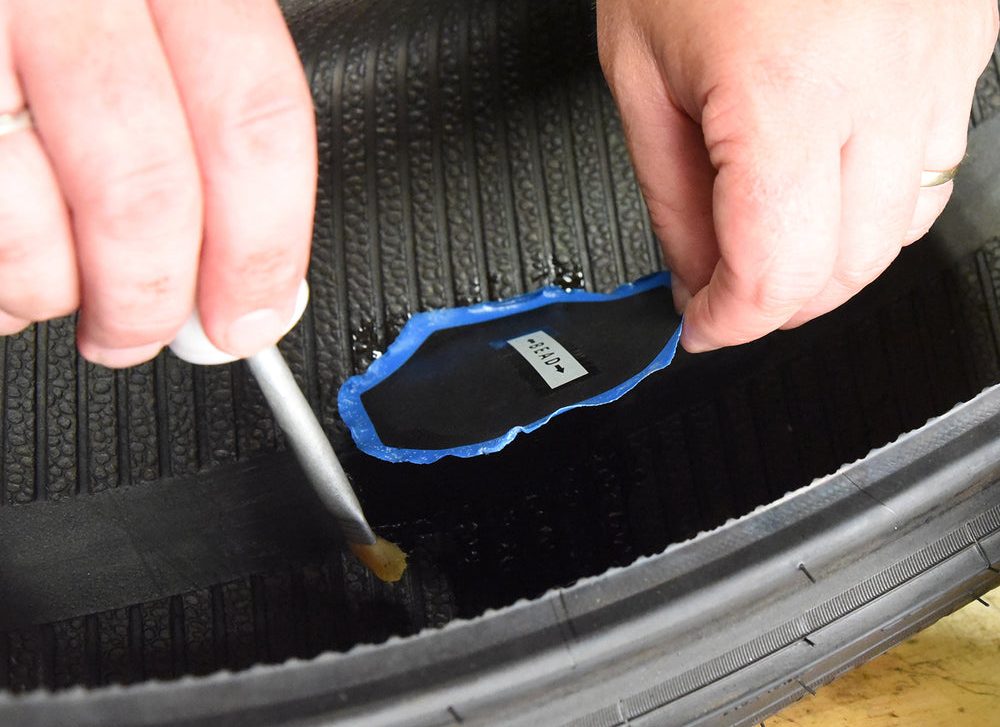 Next, you need to spin the wheel and pump it up. After repair, the car should be driven a couple of hundred meters to check the tightness of the tire. If it has not recovered, the procedure is repeated.
Next, you need to spin the wheel and pump it up. After repair, the car should be driven a couple of hundred meters to check the tightness of the tire. If it has not recovered, the procedure is repeated.
It happens that a self-tapping screw or a nail closes the hole in the tire, remaining inside. Do not rush to pull it out - until the pressure drops, you can safely get to the service for vulcanization. Sometimes the wheel begins to blow off a few weeks after the self-tapping screw got into it. Therefore, it is better to check tire pressure periodically, and if the pressure sensor lights up, you should at least visually inspect the tire for a nail head.
A bump or bulge most often occurs on the side of a tire after hitting an obstacle or hitting a hole at speed. From the impact, the sidewall carcass threads are damaged, the tire ceases to hold the load and pressure, swelling appears. Any small bump eventually turns into a larger one, and with such a defect, the wheel can burst at any time. This is a direct safety hazard because a sudden flat tire can cause loss of control and a road accident.
This is a direct safety hazard because a sudden flat tire can cause loss of control and a road accident.
Some bulges can be repaired, but no patch will ever restore a tire to factory stiffness. The ideal option in this case is to replace the tire. If a hernia has appeared on the tread, then you can extend the life of the tire with the help of cord patches - ready-to-use patches with an adhesive layer. But if swelling is found on the sidewall, the likelihood of repair is minimal, the wheel is easier to change. Blisters on low profile tires are generally not repairable.
Only car service professionals can repair a side cut. Cord patches will be needed to repair the damage, but after some time the wheel will still have to be changed. This method will work only if the gap is not in the shoulder area of the tire, then no one will repair it.
In general, cuts or punctures, unlike punctures, are considered non-repairable, since the integrity of the frame is violated.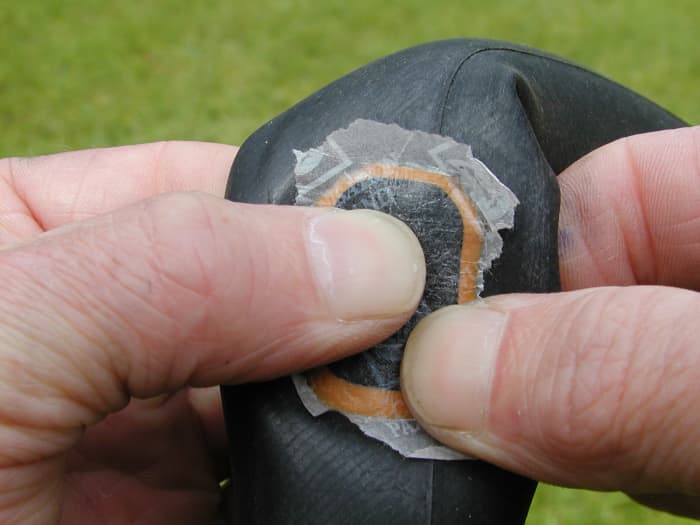 And breakdowns do occur on the go, when the tire abruptly loses pressure and has time to make only a few turns “on the rims” before it comes to a complete stop. In this situation, the cord breaks and the layers of the tire are destroyed. Even if it is possible to close the hole, it is not recommended to use such a weakened tire.
And breakdowns do occur on the go, when the tire abruptly loses pressure and has time to make only a few turns “on the rims” before it comes to a complete stop. In this situation, the cord breaks and the layers of the tire are destroyed. Even if it is possible to close the hole, it is not recommended to use such a weakened tire.
Photo: Mikhail Pletsky / Russian Look
Cracks, sidewall abrasions and unprofessional tire fitting can also lead to tire problems. Cracks can occur as a result of improper storage of tires. Their danger is that moisture begins to flow to the cord, and this already renders the frame unusable. Air can also escape through cracks. Cracks cannot be repaired and tires will not last long. A tire with cracks is deformed, blistered, and may even break while driving.
Rubbing against curbs or driving on uneven roadsides can damage the tire sidewall. When driving like this, it is worth inspecting the tires for damage regularly. If a slight wear is found, the wheels can be swapped, which will slightly extend their service life and allow you to delay the purchase of new ones.